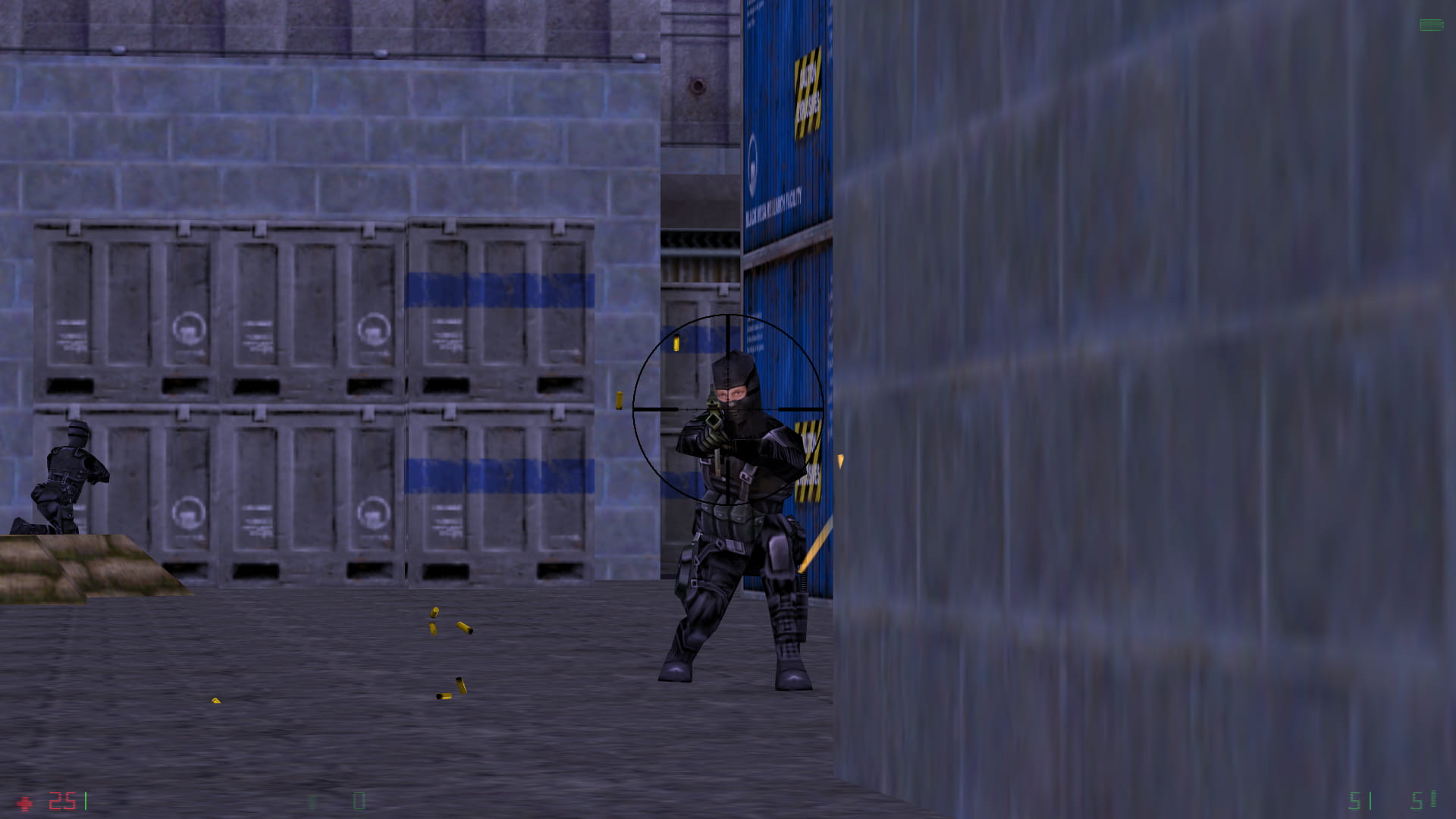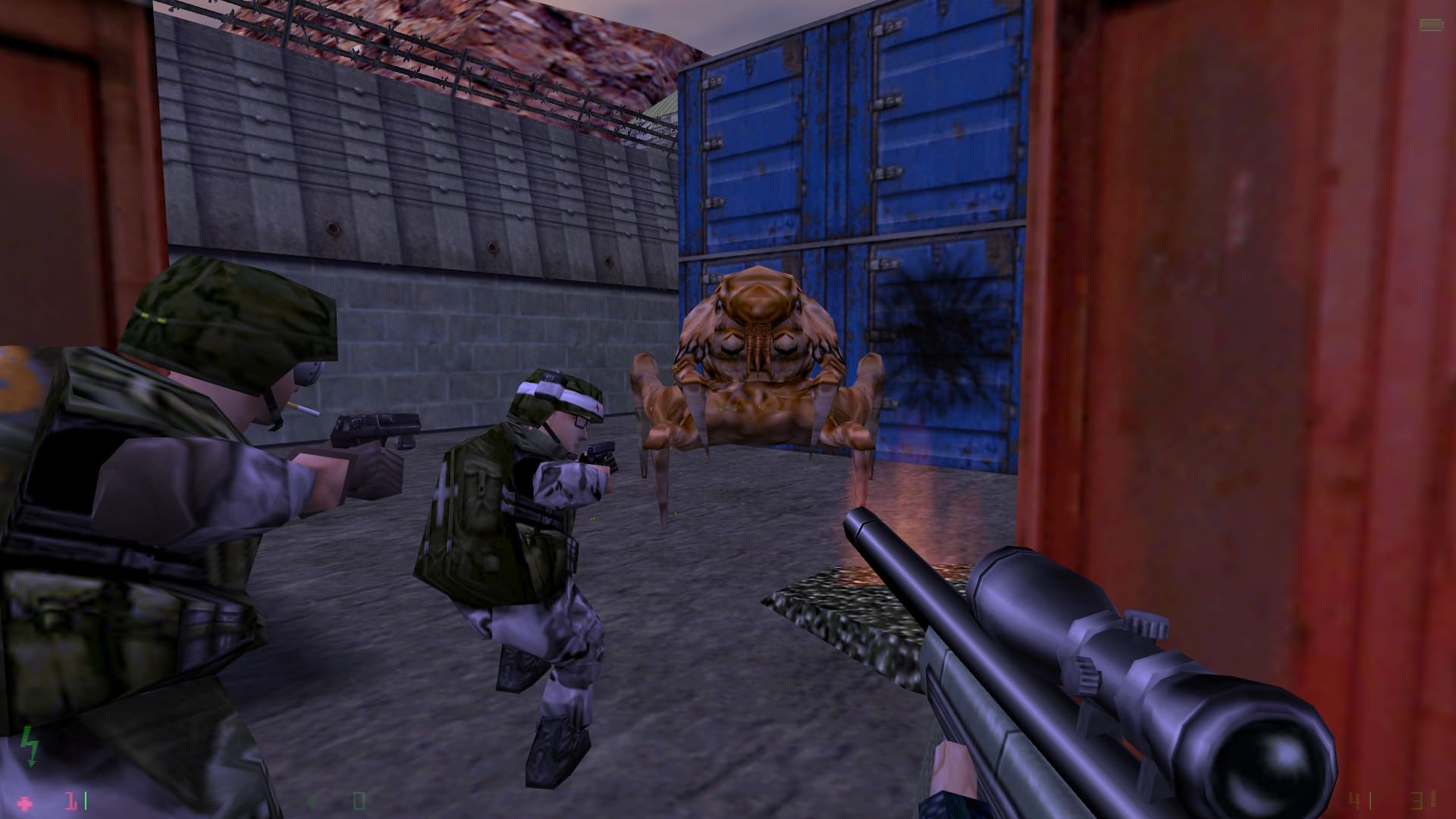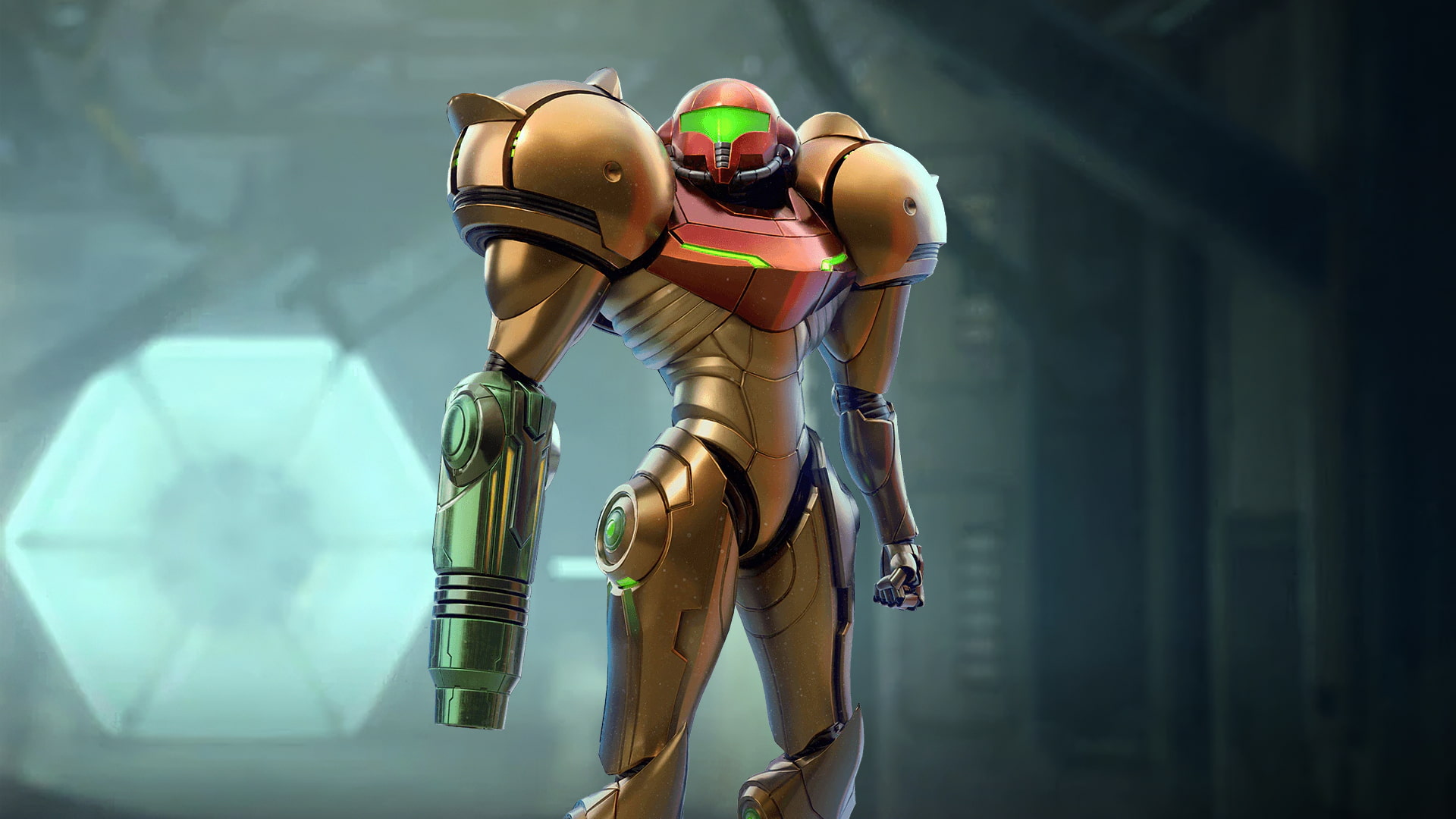Back in the early days of PC gaming, successful titles often got what was called “expansion packs”, additional content much in the vein of modern DLC, which often included new campaigns to, as the name implies, expand the base game, a win-win for game developers and players: developers got to sell extra with lower development costs and players got to experience more of what they already loved.
Valve Software’s hit debut title, Half-Life, was no exception, but as Valve moved forward with development on a full-fledged sequel, the task of developing the first game’s expansions fell to another young studio, Gearbox Software (best known today for the Borderlands series), who had a creative idea for supplementing the base game without stepping on Valve’s toes: revisiting the Black Mesa incident from the perspective of other survivors.
The first result of that endeavor would come out on November 19, 1999, exactly one year after the release of Half-Life. Half-Life: Opposing Force puts you in the boots of one of the marines that were sent to the Black Mesa Research Facility for “cleanup” after an experiment opened a rift to another dimension. Immediately lost and cut off from the rest of your crew, your primary job falls to the wayside as you struggle to simply make it out of there alive.
To this day, Opposing Force remains extremely popular with the Half-Life fanbase, often hailed as a favorite in the series. Does it deserve that status? And is it an essential experience for newer players to the Half-Life series? That’s what we’re here to find out.
Sound off like you got a pair
One thing about Opposing Force is undeniable: it has probably one of the best tutorial levels in all of gaming. Boot Camp (mirroring Half-Life’s Hazard Course) places you right in the middle of your combat training, dropping some tantalizing story teases about you getting mysteriously bumped up to special training and then letting you live said drills in order to learn how to play the game. It’s helpful even for experienced players of the first game, too, as Opposing Force throws some new mechanics at you—some excellent, others not so much—for your return trip to Black Mesa.
After you complete the (optional, but recommended) training level, you’re off to the main event. You’re Corporal Adrian Shephard, a US Marine with the Hazardous Environment Combat Unit being flown over to the Black Mesa research facility for a mission so top secret you haven’t even been told what it is just yet. Nor do you get to actually hear it from your superior officer either, as things soon take a turn for the worse and you quickly find yourself alone, unarmed and with no idea of what to do and where to go next.
Much like the original Half-Life, Opposing Force starts off as a masterclass in atmosphere and subtle storytelling. The first few minutes do a fantastic job in setting up just how screwed you are, despite the fact that you’re supposedly the stronger human force in play here. Instead, much like Gordon Freeman before him, Adrian Shephard is dumped straight in the middle of the chaos with nothing but his wits and will to survive, and while that may sound repetitive, it’s different enough to still feel fresh and exciting.
You quickly start to find the differences from Half-Life too, with not only new minor characters, but also a new arsenal. There’s no 9mm handgun or crowbar in sight for the beginning of the game; instead, you get to play soldier with a ridiculously overpowered Desert Eagle pistol, absolutely wreck any small-to-middle-sized enemy in your path with a pipe wrench (with two attack options for good measure, unlike the single-swing crowbar) and, in a deviation from the established formula, also get a second melee weapon in the form of a combat knife, much faster than the wrench but at the cost of power per swing. More new weapons eventually get added to your arsenal as you progress, including a sniper rifle, a large machine gun, an alien spore launcher and a biological “weapon” so creative I dare not spoil it here.
We are not alone
New weapons aren’t the only novelty though, as you also get a roster of new enemies, both alien and human, to use them on as you make your way through the game, though they’re a mixed bag. The gonome, a further evolution of the ever so familiar headcrab zombie, starts showing up in the third chapter, Missing in Action, and very briefly feels like an interesting concept, until you quickly realize it’s literally reusing the bullsquid AI—which also means you deal with them in very much the same way. They do, at least, spice up the occasional headcrab encounter, which is good news for players already used to dealing with their kin in the original Half-Life.
Seeing as you’re playing as one of the cleanup crew from the original Half-Life, you’d be forgiven for assuming you’re only facing off against alien enemies in Opposing Force, but you’d be gravely mistaken. Half-Life’s female Black Ops assassins make a return, not an ally but as an enemy once more, and are accompanied by a new male variant. Much like the gonome, though, the male Black Ops troops are essentially just reskinned and sped up versions of the original game’s human grunts, but they’re still fairly entertaining to fight, even if the difficulty has gone up a notch, especially as the game throws more assassins at you than Half-Life ever did.
The final big new addition to the enemy roster is a new collective of alien enemies known as Race X. Slightly controversial in the fandom due to their dubious canonical nature, in-game they’re very much a replacement for the now much rarer Xen troops, especially after the midpoint of Opposing Force. The small and nimble pit drones serve as a drop-in substitute for bullsquids and houndeyes for the most part, while the larger shock troopers are essentially Opposing Force’s answer to vortigaunts, a.k.a. the alien slaves of the first game. The large voltigores, massive insectoid enemies with bioelectric powers similar to the vortigaunts, at first offer an interesting new challenge, but the game makes the mistake of focusing a whole section on them in the dark, where their bullet-spongey nature just grows increasingly wearisome, then starts constantly throwing at least one of these at you in most subsequent combat encounters.

Unfortunately, and this may be an obvious recurring theme by now, the novelty of Race X quickly wears off as you pick up on the fact that, like the gonome and Black Ops troops before them, they’re also very much recycled AI from Half-Life. Pit drones immediately harken back to bullsquids with their long-range attacks and tendency to get up in your face to attack—they even leap up in the air if caught unaware exactly like the bullsquids—and the shock trooper’s AI often feels like a copy-paste of the human grunts’ from the original game. At best, Race X offers interesting new combinations of enemy behavior due to the mixture of AI, but it’s still a missed opportunity and one that betrays how rushed this expansion must’ve been to get out while the Half-Life hype was still high.
Friendly fire
Opposing Force’s big difference from Half-Life, of course, is that you’re no longer a scientist with an alarming affinity with deadly weaponry, but a trained soldier, and nowhere is that felt more strongly than when you come across the new friendly unit of the game, your fellow HECU troops.
In that regard, Opposing Force carries over one of the big game-changers of Half-Life, but, again, the results can be underwhelming. The grunts are nowhere as prevalent throughout the game as you might think and they’re more interesting in concept than execution. Take, for example, the HECU engineer: having a specific soldier to open new paths through the Black Mesa facility sounds great on paper, but in practice it’s not very different from dragging scientists to the retinal scanners of the first Half-Life, with the change that, this time, your escort isn’t completely defenseless (but he will put gladly himself in harm’s way), and it’s also a mechanic used sparingly throughout the game—I think I counted four or five times in my playthrough for the review. Likewise, the medic does the exact same thing the scientists in Half-Life did, but now you can choose when to heal more directly, which is helpful, but not exactly groundbreaking.
More annoying is the grunts’ pathfinding. This could be biased but, even in the more escort-intensive chapters of the original Half-Life like Questionable Ethics, I don’t really have very strong memories of growing impatient with the ally NPCs not finding their way. In Opposing Force, however, I was constantly having to try and herd the HECU towards the proper way forward, sometimes by straight up pushing them into a room so they’d actually walk through the door, completely breaking the immersion of being a cool Marine with his own squad of badass troops.

Regardless, if you think Opposing Force is some hoorah tour through the Black Mesa research facility where you kill anything in your path with ease, think again. It’s very much just more Half-Life, and the occasions where you have friendly troops by your side are relatively slim. And last in regards to friendly NPCs, you also have a new, portlier counterpart to the Barney security guards of the first Half-Life in the fan-favorite Otis, another new NPC type that appears sparingly and who I only mention because I know someone would inevitably call me out in the comments otherwise.
Tying up loose ends
Having to shepherd soldiers (pun intended) isn’t the only issue found within Opposing Force. I encountered a surprising amount of bugs in my review playthrough, something uncommon for Half-Life at this point (considering the games keep getting update with bug fixes, even twenty years removed). More than once I got stuck somewhere, from an elevator where I had to basically keep jumping so it didn’t glue me to the ground upon arrival to a sewer tunnel that was supposed to shoot me out and instead froze me in place. Every time I had to go back to a prior save and try and work around it, which was fairly annoying and not up to the standard one would expect from this series.
I also got stuck due to not knowing exactly where to go, although your mileage may vary on that. I often moved forward in the game with no idea what I was actually doing or where I was supposed to go, with one particularly egregious example being an early section with a broken down elevator where I turned off the power then spent a few good minutes trying to figure out what to do next, despite the fact I’d already played Opposing Force in the past. A challenging puzzle or two isn’t exactly a bad thing, but these mostly felt like poor signaling, something that is further evidenced by the fact that, later in the game, you often see literal lights guiding your way, something that the first Half-Life never had to do to draw the player’s attention.
Overall, the pacing of Opposing Force is also a step down from Half-Life, although somewhat understandably given that the latter was a breakthrough in that regard. The first few chapters are on par with the original, but as the game drags on, it devolves into a series of repetitive firefights with Race X and Black Ops with little variety in-between. It’s hard to escape the nagging feeling that a lot of the later chapters are just padding to make the expansion pack appear longer and therefore worth the price of admission. There’s a certain highlight near the end with a particular boss “fight” that is an obvious homage to Half-Life’s Blast Pit, but it’s buried deep in-between shooting galleries and you could almost stop playing there and not miss much.
Speaking of length, my playthrough took me about 8 to 9 hours to complete, which is nearly on-par with the first Half-Life, although, like I mentioned, a lot of it could be trimmed down for a better, leaner game. The story isn’t anything to write home about, either—critics of Half-Life’s environmental storytelling would have a field day with Opposing Force, as there’s not much here besides seeing more of the Black Mesa facility in disarray. It starts strong and ends relatively well with not much in the middle, which betrays the fact that there was little involvement from series writer Marc Laidlaw with the expansion packs, while also not giving Gearbox too much creative liberty in fear of stepping on Half-Life 2’s toes, which it still kind of does by having an entire faction of alien enemies that are never seen again. Likewise, the ending itself is a cliffhanger very reminiscent of the first Half-Life’s, but which has had no follow-through in the series, driving fans of this particular expansion insane, so don’t go in expecting any resolution by the end of it, let alone many big sweeping reveals about the overarching lore of the series.
Final thoughts
Half-Life: Opposing Force is not exactly a bad game. The expanded arsenal is a fun way to revisit the Half-Life gameplay and there are some good ideas in here, although some are half-baked or just underused. Unfortunately, it’s bogged down by what was, presumably, a rough deadline for an up-and-coming team to get to grips with Valve’s Goldsource engine and release an expansion pack as quickly as possible, leading to what feels like a lot of filler and some sections that could’ve used some polish.
If you love the original Half-Life, Opposing Force is definitely a great way to get more of that experience, but keep in mind it’s nowhere near as groundbreaking or refined as the first game. Go in with lowered expectations and bear with the bugs and annoying friendly AI pathfinding and you’ll find enough to enjoy in this messy but fun expansion.
Half-Life: Opposing Force is available for purchase on Steam.


Despite the opinion of the sourpusses, the game is very good, and I would rank it above half the other Half-Life games. Opposing Force is a masterclass.
What a brutally honest yet otherwise accurately necessary review of one of Gearbox’s great works (a shame they were led by the living embodiment of grease, and then killed of the likes of Duke Nukem and Brothers in Arms for there bloody overrated Borderlands series). Can’t wait for the Blue Shift review and how it might compare with, say, non-canon mods like Azure Sheep and Point of View (also maybe even a review of Decay, although that might be with the PC mod, because making a console
exclusive and co-op HL game sure was a bad idea).
By the way, Opposing Force is also important in the HL2: Entropy: Zero duology fanmod side of things. Hope anyone reading this will understand why.
Gotta agree with Michael, I love the warts-n-all appproach. And interesting rating – the way it built up felt like it was leading for a five or a six. But it is hard to deny its influence and the game has a lot to love. And it’s not Gearbox’s fault they weren’t allowed to tell a progressive story in the Half-Life universe.
Still, I always found the game plays like a fever dream of Half-Life. There was something about the gameplay design that felt off: traversal and enemy encounter never felt as intuitive, natural or streamlined as Valve’s games. In hindsight, those floating lights being a most damning case.
A five or six is good enough for this sourpuss.
@George_Stukas By the standards of the other Half-Life games, maybe it’s a six. By the standards of most games, and especially games of its time, I stand by the original score.